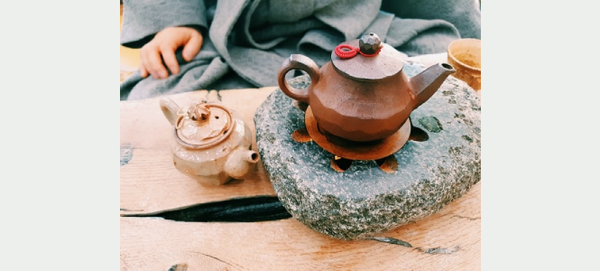Fascinating Tea Traditions From Around the World
The tea journey that began in one little part of the planet has taken the world by storm over the years, bringing bliss to tea connoisseurs with every brew of each blend. As tea brews started charming their way into the hearts of its consumers, many different tea traditions were born.
The beliefs about tea in different countries are just as indulging as a perfectly brewed cup of tea! Thanks to these little warm cups brimming with bliss, people coming from different lands don’t have to look too far to find something incredibly delightful to bond over. Here are some of the tea rituals around the world-
Tea Traditions Of India
In India, tea first appeared in the ancient scripts of the Ramayana. According to legend, Lakshman, the brother of Lord Rama was injured. Hanuman, Lord Rama’s pupil was sent to bring the ‘Sanjeevani Booti’. The leaves of this plant were applied to Lakshman’s wounds and he healed miraculously. Sanskrit scholars believe the ‘Sanjeevani Booti’ is tea itself.
Today, tea rituals in India are a part of everyday life. You’ll find a tea stall at every nook and corner of major cities with each having their own version of the tea. People from Delhi prefer the ‘Malai-maar Ke’ version which is Indian Masala Chai served with a dollop of fresh cream while Mumbaikars love their ‘Cutting Chai’ (half a cup of tea). The highways of Northern India are marked by smaller outlets that brew and serve tea in earthen pots called ‘Khullad’.
Tea Traditions Of Japan
In Japan, for close to six centuries tea remained an imperial drink. In the 14th century tea master Murato Shuko uncovered the meditative qualities of tea. Set on a mission to bring peace to people, he created a Tea Hut which stood for simplicity and equality. These rooms ensured that everyone sat together, leaving aside their differences, experiencing Zen while sipping on tea. Today, there are two prevailing philosophies that run through Japanese tea ceremonies:
Ichigo Ichie: Every human encounter is believed to be a singular occasion which can and will never recur in the same way ever again.
Wabi: Emphasis is placed on finding beauty in the imperfect and appreciating the profound in all things nature.
These philosophies changed the outlook of the Japanese towards tea; making it more than just a medicine or beverage of entertainment. The Japanese started revering tea as sacred.
Tea Traditions Of United Kingdom
The British started adding a dash of milk to the tea in the 17th and 18th century. The fine bone china crockery was always at a risk of cracking with the heat of the freshly brewed tea. This led to the adding of milk which reduced the temperature of the beverage and prevented tea cups from breaking. This also helped reduce the astringency of the black tea that they loved so much.
The ‘Afternoon Tea’ ceremony was introduced by Anna, the 7th Duchess of Bedford. Each day, by late noon, the Duchess would feel low on energy. As a solution, she started having tea with a light snack. Soon, she started inviting her friends for the sessions. This craze broke out to the commoners and they started enjoying high teas in the evening. The name ‘high tea’ was given because of the height of the tables that the common people used.
Tea Traditions Of Russia
The cold land of Russia first encountered tea when a Mongolian ruler gifted it to the Russian tsar Michael I (Mikhail Fyodorovich Romanov) in the 1630s. A few years later, this luxury beverage was gifted by a Chinese ambassador to Alexis I (Aleksey Mikhailovich) during trade negotiations with Russia. And it was this second round of gifting that got Russians to like tea.
Typically brewed in a samovar and served in unique handcrafted porcelain, tea is an integral part of the Russian culture. In the 19th century, it was Russia’s favorite afternoon beverage. It inspired poets like Karamzin and writers like Alexander Ostrovsky. Today, tea is considered the national drink of Russia. The Russians prefer their tea strong and sweet, and sometimes, served with mint or lemon, or sweetened with fruit jam.
Tea Traditions Of South Africa
Tea was introduced to South Africa in 1850 when the seeds of the Assam Tea were imported from Calcutta for commercial purposes. The Orchardson brothers, the sons of the famous artist Sir William Orchardson were the first ones to plant tea trees in Africa. Soon, Kenya became famous for growing teas and established the Kenya Tea Growers Association in 1933.
In West Africa, the tea ceremony goes by the name ‘Attaya’, and is anything but formal. Every Attaya consists of three rounds of tea drinking. The first round of tea is very bitter and it represents the beginning of life and the pains of growing up. The second round is sweeter with a hint of mint. This symbolizes the sweetness of mid-life, love and marriage. The third round is a weak tea which represents old age.
Sip On The Most Popular Teas Around The World With Us
Tea Culture of the World is home to passionately curated tea blends with hand-picked tea leaves and rare, exotic ingredients from the renowned estates across the world - all safely delivered to your doorstep. Explore our collections of tea blends today and brew lingering experiences for the mind, body and soul!


